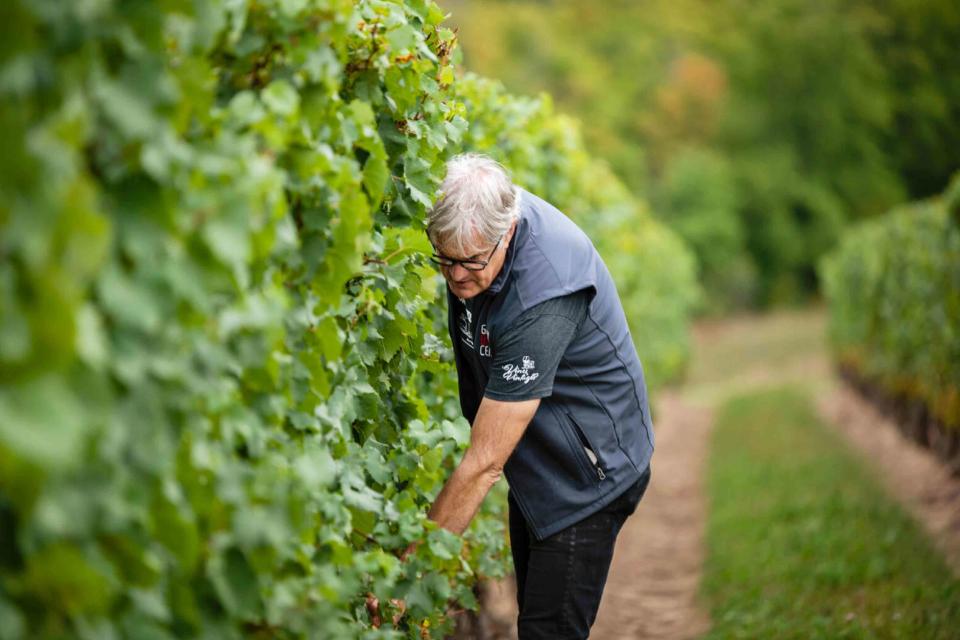Where to Sip and Stay to Experience Niagara’s Surprising Wine Scene
There’s way more to the Niagara Peninsula than just ice wine.

Karen Black Photography / Indigo Pet Project
Thomas Bachelder is one of the Niagara regionâs most passionate advocates and talented winemakersThe world of wine is well supplied with quixotic figures hell-bent on wringing a beautiful drink out of an unpromising location. There is wine made on volcanoes, in deserts, and on hillsides so steep that every grape must be picked by hand. But there may be no wilder location than just inland of the Canadian side of Lake Ontario, where temperatures shiver below freezing in the depths of winter.
In late March, just beyond Niagara-on-the-Lake, inside a modern tasting room stacked high with excellent wines (including a terrific Blanc de Blancs), Stratus winemaker Dean Stoyka gleefully showed me a video he had taken while working in the vines on December 23—in a blizzard. I was tempted to tell him about this great little place I’d just discovered, with a delightful climate and some potential for winemaking, called Sonoma.
Niagara is known for ultra-sweet ice wine, made from grapes that freeze on the vine, concentrating the sugars. Peller Estates even has a 300-square-foot “ice wine lounge,” a bespoke igloo where you can spend a moment sipping wine in what feels like the inside of a midwinter Ontario grape. But for those of us who prefer our sugars fully fermented, Niagara’s dry wines are a revelation. It turns out that the extreme cold, when allied with the breezes sweeping across a lake the size of New Jersey, doesn’t prevent grapes from ripening. Quite the contrary: Winds off the lake that are still fresh in summer and warm in autumn lengthen the growing season. The vines must be buried to protect them in winter, but the resulting wines are good enough to provide compensation for the frigid vineyard work.
There was still a distinctly chill wind blowing in from the lake when I visited 13th Street Winery, but their Vineyard Kitchen & Bistro was already open and humming with visitors at the bar, pairing wines with good charcuterie and house-baked bread on the veranda. Winemaker Jean Pierre Colas poured me two fizzes: an easy-drinking Gamay and a more traditional blend of Pinot Noir and Chardonnay, which was superb—no surprise, as Colas is originally from Chablis, just south of Champagne. “I came here not expecting much, but the soil was so mineral.” He’s now been here 24 years, enjoying the challenges of this environment, using all his skill to create the most elegant wines possible, a choice, he said, between “making lace and making jogging pants.”
Ten miles west, driving parallel to the lakeshore through an area appropriately named Vineland, is Hidden Bench Estate Winery, home to an exceptionally charming 150-year-old farmhouse. There’s no restaurant, just a tasting room, which is worth visiting, as the excellent wines (mostly Pinot, Chardonnay, and Riesling) are almost impossible to find elsewhere.
Ontario is Canada’s biggest producer by volume, thanks in part to large enterprises like Peller, which comprises several brands. But it was the boutique wineries that interested me—and with most of those, reputation far exceeds output. Thomas Bachelder, the region’s charismatic champion, makes wines in his Beamsville Bench garage. (Visits are by appointment for subscribers to their email list only, so sign up before you go.) In a good year, he told me as he opened a range of single-vineyard crus of outstanding quality, he does 7,000 cases. His exuberance dimmed briefly when he talked about the “Sadness of 2022,” when wet and unseasonably cold weather crushed the budding—and highly vulnerable—vines, meaning there will be few bottles from that vintage. However, he perked up again when discussing his former assistant Kelly Mason, now winemaker at Domaine Queylus. “I’d have cleaned drains to work with Thomas,” Mason said when we met in Queylus’ pleasant tasting room, with its comfortable marine-blue armchairs and vineyard views. There are tasting flights and light platters on offer—and again, this is the place to buy bottles to take home that are difficult to source in the U.S. Her own minuscule-production label Mason Vineyard was even harder to find—at least, until I discovered Aladdin’s cave over dinner.
In Niagara-on-the-Lake, a pretty town with low 19th-century buildings located at the point where the Niagara River meets Lake Ontario, Treadwell serves a four-course prix fixe menu with a fabulous choice of local wines. (The restaurant is situated inside the hotel 124 on Queen.) And to my delight, after the sparkling rosé from Kew Vineyards and before the Five Rows Riesling from near Niagara Falls, out came a glass of Mason Vineyard Chardonnay. (Bachelder’s name is also on the label.) The elegant, minerally wine was a perfect match for the richness of poached egg and truffles. I hadn’t expected such fine cuisine in a small lakeside Canadian town—but then, I hadn’t anticipated superb wines in such an unpromising climate, either. It turns out that wine regions, like good Blanc de Blancs, can be better chilled.
Where to stay
124 on Queen This stately, modern hotel with a 12,000- square-foot spa located just a couple blocks from Lake Ontario doubles as the home to Treadwell, as well as a more casual restaurant for those moments when four courses with wine pairings is a little too much. Rooms from $342
For more Food & Wine news, make sure to sign up for our newsletter!
Read the original article on Food & Wine.

